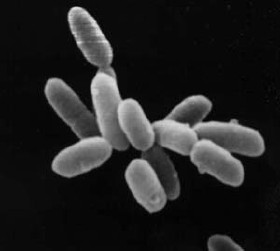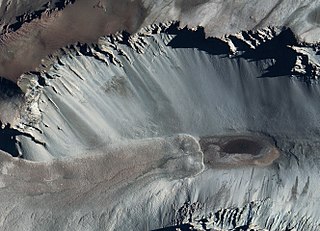A halophile is an extremophile that thrives in high salt concentrations. In chemical terms, halophile refers to a Lewis acidic species that has some ability to extract halides from other chemical species.

Nanoarchaeota is a proposed phylum in the domain Archaea that currently has only one representative, Nanoarchaeum equitans, which was discovered in a submarine hydrothermal vent and first described in 2002.

Halobacterium is a genus in the family Halobacteriaceae.
The Vestfold Hills are rounded, rocky, coastal hills, 512 square kilometres (198 sq mi) in extent, on the north side of Sorsdal Glacier on the Ingrid Christensen Coast of Princess Elizabeth Land, Antarctica. The hills are subdivided by three west-trending peninsulas bounded by narrow fjords. Most of the hills range between 30 and 90 metres in height, with the highest summit reaching nearly 160 metres (520 ft).

Haloarchaea are a class of the Euryarchaeota, found in water saturated or nearly saturated with salt. Halobacteria are now recognized as archaea rather than bacteria and are one of the largest groups. The name 'halobacteria' was assigned to this group of organisms before the existence of the domain Archaea was realized, and while valid according to taxonomic rules, should be updated. Halophilic archaea are generally referred to as haloarchaea to distinguish them from halophilic bacteria.

Don Juan Pond is a small and very shallow hypersaline lake in the western end of Wright Valley, Victoria Land, Antarctica, 9 kilometres (5.6 mi) west from Lake Vanda. It is wedged between the Asgard Range to the south and the Dais Range to the north. On the west end is a small tributary and a rock glacier. With a salinity level of 33.8%, Don Juan Pond is the saltiest of the Antarctic lakes. This salinity causes significant freezing-point depression, allowing the pond to remain liquid even at temperatures as low as −50 °C (−58 °F).
Halorubrum is a genus in the family Halorubraceae. Halorubrum species are usually halophilic and can be found in waters with high salt concentration such as the Dead Sea or Lake Zabuye.

Blood Falls is an outflow of an iron oxide–tainted plume of saltwater, flowing from the tongue of Taylor Glacier onto the ice-covered surface of West Lake Bonney in the Taylor Valley of the McMurdo Dry Valleys in Victoria Land, East Antarctica.

Cytophaga is a genus of Gram-negative, gliding, rod-shaped bacteria. This bacterium is commonly found in soil, rapidly digests crystalline cellulose C. hutchinsonii is able to use its gliding motility to move quickly over surfaces. Although the mechanism for this is not known, there is a belief that the flagellum is not used
Rhodopseudomonas is a genus of bacteria from the family Nitrobacteraceae.
Organic Lake is a lake in the Vestfold Hills in eastern Antarctica. It was formed 6,000 years ago when sea levels were higher; it is isolated, rather shallow 7.5 metres (25 ft), meromictic, a few hundred meters in diameter and has extremely salty water. It has the highest recorded concentration of dimethyl sulfide in any natural body of water.
Nanohaloarchaea is a clade of diminutive archaea with small genomes and limited metabolic capabilities, belonging to the DPANN archaea. They are ubiquitous in hypersaline habitats, which they share with the extremely halophilic haloarchaea.
Methanococcoides burtonii is a methylotrophic methanogenic archaeon first isolated from Ace Lake, Antarctica. Its type strain is DSM 6242.
Desulfurobacterium thermolithotrophum is a species of autotrophic, sulphur-reducing bacterium isolated from a deep-sea hydrothermal vent. It is the type species of its genus, being thermophilic, anaerobic, Gram-negative, motile and rod-shaped, with type strain BSAT.
Paludibacter is a Gram-negative, strictly anaerobic, chemoorganotrophic and non-motile genus from the phylum Bacteroidota.

Halorubrum lacusprofundi is a rod-shaped, halophilic Archaeon in the family of Halorubraceae. It was first isolated from Deep Lake in Antarctica in the 1980s.
Knoellia is a genus of Gram positive, aerobic, non-endosporeforming bacteria. Species in this genus are mesophilic and have cells that are irregular rods or coccoid.
Pleomorphomonadaceae is a family of Alphaproteobacteria.
Parvibacter is a genus in the phylum Actinomycetota containing a single species, Parvibacter caecicola.






